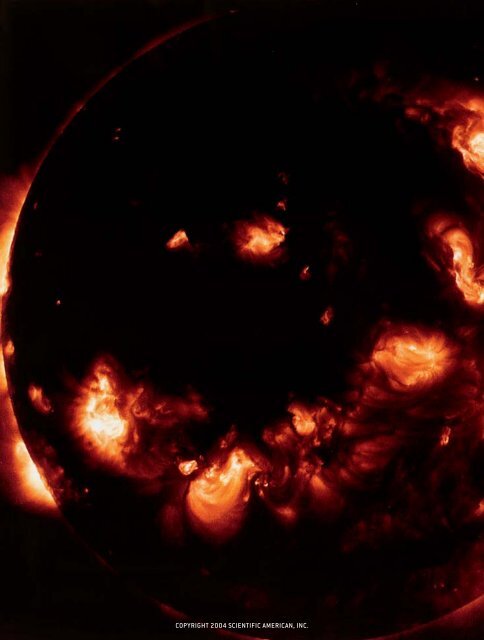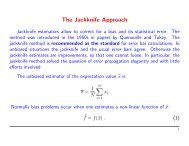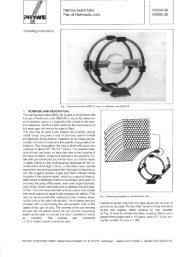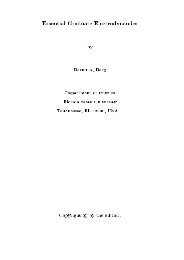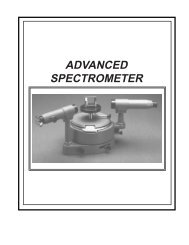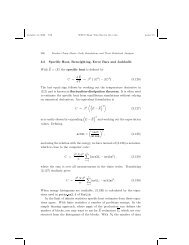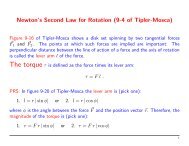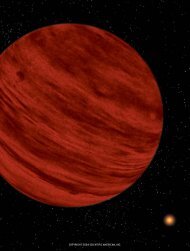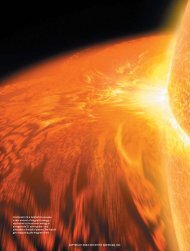The Stellar Dynamo - Scientific American Digital
The Stellar Dynamo - Scientific American Digital
The Stellar Dynamo - Scientific American Digital
- No tags were found...
Create successful ePaper yourself
Turn your PDF publications into a flip-book with our unique Google optimized e-Paper software.
COPYRIGHT 2004 SCIENTIFIC AMERICAN, INC.
<strong>The</strong><br />
<strong>Stellar</strong><br />
<strong>Dynamo</strong><br />
Sunspot cycles—on other stars—are helping<br />
astronomers study the sun’s variations and the<br />
ways they might affect Earth<br />
By Elizabeth Nesme-Ribes, Sallie L. Baliunas<br />
and Dmitry Sokoloff<br />
MAGNETIC FIELDS on the<br />
sun are rendered visible in<br />
this x-ray photograph by the<br />
curving contours of solar flares.<br />
<strong>The</strong> lines of magnetic fields erupt<br />
from the sun’s surface and heat the<br />
gases of the surrounding corona to up to<br />
25 million degrees C, causing them to glow.<br />
Flares are more frequent during sunspot maxima.<br />
In 1801, musing on the vagaries of English weather, astronomer William Herschel<br />
observed that the price of wheat correlated with the disappearance of sunspots. But<br />
the pattern soon vanished, joining what scientists at large took to be the mythology<br />
connecting earthly events with solar ones. That the sun’s brightness might possibly<br />
vary, and thereby affect Earth’s weather, remained speculative.<br />
Thus, in the mid-1980s, when three solar satellites—Solar Maximum Mission,<br />
Nimbus 7 and Earth Radiation Budget—reported that the sun’s radiance<br />
was declining, astronomers assumed that all three instruments were failing. But<br />
the readings then perked up in unison, an occurrence that could not be attributed<br />
to chance. <strong>The</strong> sun was cooling off and heating up; furthermore, the variation<br />
was connected with the number of spots on its face.<br />
In recent years one of us (Baliunas) has observed that other stars undergo rhythmic<br />
changes much like those of our sun. Such studies are helping refine our understanding<br />
of the “dynamo” that drives the sun and other stars. Moreover, they<br />
have revealed a strong link between “star spots” and luminosity, confirming the<br />
patterns discovered in our sun. And yet astrophysicists, including the three of us,<br />
are still debating the significance of the sun’s cycles and the extent to which they<br />
might influence Earth’s climate.<br />
Updated from the August 1996 issue 35<br />
COPYRIGHT 2004 SCIENTIFIC AMERICAN, INC.
NATIONAL SOLAR OBSERVATORY/SACRAMENTO PEAK; NATIONAL SOLAR OBSERVATORIES/KITT PEAK (inset)<br />
SUNSPOTS are relatively cool regions formed where magnetic fields<br />
emerge from the sun, thereby suppressing the upwelling of hot gases<br />
from the interior. Elsewhere on the surface, tightly coiled cells of<br />
cyclonically flowing gases show up as granules. Near a sunspot the<br />
Sunspots<br />
THE EARLIEST KNOWN sunspot records<br />
are Chinese documents that go<br />
back 2,000 years, preserving observations<br />
made by the naked eye. From 1609<br />
to 1611 Johannes Fabricius, Thomas<br />
Harriot, Christoph Scheiner and Galileo<br />
Galilei, among others, began telescopic<br />
studies of sunspots. <strong>The</strong>se records, as<br />
German astronomer Samuel Heinrich<br />
Schwabe announced in 1843, displayed<br />
a prominent periodicity of roughly 10<br />
years in the number of observed sunspot<br />
groups. By the 20th century George<br />
magnetic fields organize the gaseous flow into lines resembling iron<br />
filings near a bar magnet. <strong>The</strong> magnetogram (inset) shows field lines<br />
emerging at one sunspot (yellow) and reentering at another (blue);<br />
such sunspot pairs are common.<br />
Ellery Hale of the Mount Wilson Observatory<br />
in California found those dark<br />
surface irregularities to be the seat of intense<br />
magnetic fields, with strengths of<br />
several thousand gauss. (Earth’s magnetic<br />
field is, on the average, half a gauss.)<br />
Sunspots appear dark because they<br />
Sunspot Number<br />
Maunder minimum<br />
1620 1640 1660 1680 1700 1720 1740 1760 1780 1800 1820 1840 1860 1880<br />
MAXIMUM<br />
MINIMUM<br />
ELEVEN-YEAR CYCLES of sunspot activity were interrupted between 1645 and 1715<br />
by a period of quiescence. This dearth of sunspots, called the Maunder minimum,<br />
coincided with unusually cool temperatures across northern Europe, indicating that<br />
solar fluctuations influence Earth’s climate. <strong>The</strong> regular pulsing of the sun’s activity<br />
(right) was observed over one cycle at the Paris Observatory. <strong>The</strong>se photographs were<br />
taken in violet light emitted by ionized calcium; the technique that produced them is<br />
now used to study the magnetic activity of other stars.<br />
1979 1982 1986<br />
36 SCIENTIFIC AMERICAN THE SECRET LIVES OF STARS<br />
COPYRIGHT 2004 SCIENTIFIC AMERICAN, INC.
SUNSPOTS ARE 2,000 DEGREES C COOLER<br />
than the surrounding surface; they would<br />
GLOW ORANGE-RED AGAINST A NIGHT SKY.<br />
are 2,000 degrees Celsius cooler than the<br />
surrounding surface of the sun; they<br />
would glow orange-red if seen against<br />
the night sky. <strong>The</strong> spots form when<br />
strong magnetic fields suppress the flow<br />
of the surrounding gases, preventing<br />
them from carrying internal heat to the<br />
surface. Next to the sunspots are often<br />
seen bright areas called plages (after the<br />
French word for “beach”). <strong>The</strong> magnetic<br />
field lines tend to emerge from the surface<br />
at one spot to reenter the sun at another,<br />
linking the spots into pairs that resemble<br />
the two poles of a bar magnet<br />
that is oriented roughly east-west.<br />
At the start of each 11-year cycle,<br />
sunspots first appear at around 40 degrees<br />
latitude in both hemispheres; they<br />
form closer to the equator as the cycle<br />
progresses. At sunspot minimum, patches<br />
of intense magnetism, called active regions,<br />
are seen near the equator. Aside<br />
from the sunspots, astronomers have observed<br />
that the geographic poles of the<br />
sun have weak overall magnetic fields of<br />
a few gauss. This large-scale field has a<br />
“dipole” configuration, resembling the<br />
field of a bar magnet. <strong>The</strong> leading sunspot<br />
in a pair—the one that first comes<br />
into view as the sun rotates from west to<br />
east—has the same polarity as the pole of<br />
its hemisphere; the trailing sunspot has<br />
1920 1940 1960 1980 2000<br />
MAXIMUM<br />
1988 1990<br />
PARIS OBSERVATORY<br />
Sunspot Number<br />
NOAA; PETER SAMEK Slim Films<br />
the opposite polarity. Moreover, as Hale<br />
and Seth B. Nicholson had discovered by<br />
1925, the polarity patterns reverse every<br />
11 years, so that the total magnetic cycle<br />
takes 22 years to complete. But the sun’s<br />
behavior has not always been so regular.<br />
In 1667, when the Paris Observatory<br />
was founded, astronomers there began<br />
systematic observations of the sun, logging<br />
more than 8,000 days of observation<br />
over the next 70 years. <strong>The</strong>se records<br />
showed very little sunspot activity.<br />
This important finding did not raise<br />
much interest until the sunspot cycle was<br />
discovered, prompting Rudolf Wolf of<br />
Zürich Observatory to scrutinize the<br />
records. Although he rediscovered the<br />
sunspot lull, Wolf’s finding was criticized<br />
on the grounds that he did not use all the<br />
available documents.<br />
During the late 1880s, first Gustav<br />
F. W. Spörer and then E. Walter Maunder<br />
reported that the 17th-century solar<br />
anomaly coincided with a cold spell in<br />
Europe. That astonishing observation<br />
lay neglected for almost a century, with<br />
many astronomers assuming that their<br />
predecessors had not been competent<br />
enough to count sunspots. It was only in<br />
1976 that John A. Eddy of the High Altitude<br />
Observatory in Boulder, Colo., reopened<br />
the debate by examining the<br />
Paris archives and establishing the validity<br />
of what came to be known as the<br />
Maunder minimum.<br />
Minze Stuiver, while at Yale University,<br />
Hans Suess of the University of California<br />
at San Diego and others had discovered<br />
that the amount of carbon 14 in<br />
tree rings increased during the dearth of<br />
sunspots. This radioactive element is created<br />
when galactic cosmic rays transmute<br />
nitrogen in the upper atmosphere.<br />
<strong>The</strong>ir findings suggested that when the<br />
magnetic fields in the solar wind—the<br />
blast of particles and energy that flows<br />
from the sun—are strong, they shield<br />
Earth from cosmic rays, so that less carbon<br />
14 forms; the presence of excess carbon<br />
14 indicated a low level of magnetic<br />
activity on the sun during the Maunder<br />
phase. Eddy thus reinforced the connection<br />
between the paucity of sunspots and<br />
a lull in solar activity.<br />
Aside from the rarity of sunspots<br />
during the Maunder minimum, the Paris<br />
archives brought to light another oddity:<br />
from 1661 to 1705, the few sunspots<br />
that astronomers sighted were usually in<br />
the southern hemisphere. <strong>The</strong>y were also<br />
traveling much more slowly across the<br />
sun’s face than present-day sunspots do.<br />
Only at the beginning of the 18th century<br />
did the sun assume its modern appearance,<br />
having an abundance of<br />
sunspots rather evenly distributed between<br />
the two hemispheres.<br />
<strong>The</strong> Solar <strong>Dynamo</strong><br />
THE MAGNETIC ACTIVITY of the<br />
sun is believed to reside in its convective<br />
zone, the outer 200,000 kilometers where<br />
churning hot gases bring up energy from<br />
the interior. <strong>The</strong> fluid forms furious<br />
whorls of widely different sizes: the best<br />
known is an array of convective cells or<br />
granules, each 1,000 kilometers across<br />
at the surface but lasting only a few minutes.<br />
<strong>The</strong>re are also “supergranules” that<br />
are 30,000 to 50,000 kilometers across<br />
and even larger flows. Rotation gives rise<br />
to Coriolis forces that make the whorls<br />
flow counterclockwise in the northern<br />
hemisphere (if one is looking down at<br />
the surface) and clockwise in the southern<br />
hemisphere; these directions are called<br />
cyclonic.<br />
Whether similar cyclones exist underneath<br />
the surface is not known. Deep<br />
within, the convective zone gives way to<br />
the radiative zone, where the energy is<br />
transported by radiation. <strong>The</strong> core of the<br />
sun, where hydrogen fuses into helium<br />
to fuel all the sun’s activity, seems to rotate<br />
rigidly and slowly compared with<br />
the surface.<br />
www.sciam.com SCIENTIFIC AMERICAN 37<br />
COPYRIGHT 2004 SCIENTIFIC AMERICAN, INC.
a b c<br />
North<br />
Pole<br />
North<br />
Pole<br />
North<br />
Pole<br />
SOLAR DYNAMO generates the sun’s magnetic field and also causes it to change orientation every<br />
11 years. Suppose that the initial magnetic field (a) resembles that of a bar magnet with its north<br />
pole (+) near the sun’s geographic north pole. <strong>The</strong> magnetic field lines are carried along with the<br />
electrically charged gases. <strong>The</strong> faster flow at the equator therefore distorts the field lines (b) until<br />
they wrap tightly (c) around the sun. But the field lines then resist the stretching and unwind,<br />
QUADRUPOLE<br />
DIPOLE<br />
<strong>The</strong> first description of how the sun’s<br />
gases conspire to create a magnetic field<br />
was proposed in 1955 by Eugene N.<br />
Parker of the University of Chicago. Because<br />
of the high temperature, the atoms<br />
of hydrogen and helium lose their electrons,<br />
thereby giving rise to an electrically<br />
charged substance, or plasma. As<br />
the charged particles move, they generate<br />
magnetic fields. Recall that the lines<br />
describing magnetic fields form continuous<br />
loops, having no beginning or<br />
end—their density (how closely together<br />
the lines are packed) indicates the intensity<br />
of the magnetic field, whereas<br />
their orientation reveals the direction.<br />
Because plasma conducts electricity very<br />
efficiently, it tends to trap the field lines:<br />
if the lines were to move through the<br />
plasma, they would generate a large, and<br />
energetically expensive, electric current.<br />
Thus, the magnetic fields are carried<br />
along with the plasma and end up getting<br />
twisted. <strong>The</strong> entwined ropes wrap<br />
together fields of opposite polarity, which<br />
tend to cancel each other. But the sun’s<br />
rotation generates organizational forces<br />
that periodically sort out the tangles and<br />
create an overall magnetic field. This automatic<br />
engine, which generates magnetism<br />
from the flow of electricity, is the<br />
solar dynamo.<br />
<strong>The</strong> dynamo has two essential ingredients:<br />
the convective cyclones and the<br />
sun’s nonuniform rotation. During the<br />
mid-1800s, Richard C. Carrington, an<br />
English amateur astronomer, found that<br />
the sunspots near the equator rotate faster,<br />
by 2 percent, than those at midlatitudes.<br />
Because the spots are floating with<br />
the plasma, the finding indicates that the<br />
sun’s surface rotates at varying speeds.<br />
<strong>The</strong> rotation period is roughly 25 days at<br />
the equator, 28 days at a latitude of 45<br />
degrees and still longer at higher latitudes.<br />
This differential rotation should extend<br />
all the way through the convective zone.<br />
Now suppose that the initial shape of<br />
the sun’s field is that of a dipole oriented<br />
roughly north-south. <strong>The</strong> field lines get<br />
pulled forward at the equator by the<br />
faster rotation and are deformed in the<br />
east-west direction. Ultimately, they lie<br />
parallel to the equator and float to the<br />
surface, erupting as pairs of sunspots.<br />
But Coriolis forces tend to align the<br />
cyclones and thereby the sunspots, which<br />
are constrained to follow the plasma’s<br />
gyrations. <strong>The</strong> cyclones arrange the sunspots<br />
so that, for example, a trailing sunspot<br />
in the northern hemisphere lies at<br />
a slightly higher latitude than a leading<br />
one. As the equatorial field lines are<br />
stretched, they eventually unwind and<br />
drift outward. <strong>The</strong> trailing sunspot<br />
reaches the pole first, effectively reversing<br />
the magnetic field there. (Recall that<br />
the trailing spot has a polarity opposite<br />
that of the nearest pole.) Those field lines<br />
that initially extended far beyond the<br />
sun reconnect into loops and are blown<br />
away by the solar wind. In this manner,<br />
the overall magnetic field flips, and the<br />
cycle begins again.<br />
<strong>The</strong>re is, however, a caveat. This simple<br />
picture seems to be at odds with results<br />
from helioseismology, the science of<br />
sunquakes. <strong>The</strong> model requires the sun<br />
to rotate faster at the interior; in contrast,<br />
results from the Global Oscillation Network<br />
Group, an international collaboration<br />
of observatories, show that the rotation<br />
velocity near the equator decreases<br />
downward. Such experiments are<br />
providing accurate information on internal<br />
motions of the sun and thereby help-<br />
PETER SAMEK Slim Films<br />
38 SCIENTIFIC AMERICAN THE SECRET LIVES OF STARS<br />
COPYRIGHT 2004 SCIENTIFIC AMERICAN, INC.
d<br />
North<br />
Pole<br />
ing Mausumi Dikpati and Peter Gilman<br />
of the High Altitude Observatory and<br />
others to refine dynamo theory.<br />
But what happened during the Maunder<br />
minimum To explain this lull, two<br />
of us (Nesme-Ribes and Sokoloff) noted<br />
that apart from a dipole pattern, the<br />
magnetic field must also have a small<br />
quadrupole component, resembling the<br />
field of two bar magnets placed side by<br />
side. If the quadrupole oscillates at a<br />
North<br />
Pole<br />
moving up toward the surface and erupting as sunspot pairs (d). <strong>The</strong> sunspots drift toward the poles,<br />
with the trailing sunspot reaching first; as a result, the overall field flips (e). In addition to the dipole<br />
field above, the sun probably also has a “quadrupole” field (opposite page, red) whose “beating” with<br />
the dipole field was responsible for the Maunder minimum.<br />
e<br />
slightly different rate than the dipole, the<br />
sunspots in one hemisphere are produced<br />
slightly earlier than those in the other<br />
hemisphere—precisely what we observe<br />
now. Furthermore, over the past four<br />
centuries, a few solar cycles showed different<br />
numbers of sunspots in the northern<br />
and southern hemispheres. This pattern<br />
seems to repeat every century or so,<br />
exactly what one would expect if the dipole<br />
“beats” with a weak quadrupole.<br />
But suppose that the quadrupole<br />
field is as strong as the dipole. <strong>The</strong> equatorial<br />
field lines that result from stretching<br />
this combination will then cancel out<br />
in one hemisphere yet remain in the other.<br />
And the few spots that do appear will<br />
all be in one hemisphere, just as 17thcentury<br />
astronomers noted during the<br />
Maunder minimum.<br />
We can encapsulate the relation between<br />
the dipole and quadrupole fields<br />
in a “dynamo number” D. It is the product<br />
of the helicity, or spiraling motion,<br />
of the plasma and the local rate of<br />
change of rotation. When D is very<br />
small, the magnetic field tends to die<br />
out; as D increases, the quadrupole field<br />
shows up, with the dipole following. Beyond<br />
a critical value, both components<br />
of the field are steady. But as D increases<br />
further, the dynamo becomes periodic,<br />
increasing and decreasing; this is the<br />
regime in which the sun now lies. A<br />
weak quadrupole field, beating in phase<br />
with the dipole, leads to short and intense<br />
cycles; a stronger quadrupole field,<br />
if slightly out of phase with the dipole<br />
field, lengthens and weakens the sunspot<br />
cycle. Far beyond the critical dynamo<br />
number, chaos results.<br />
Dynamic Stars<br />
AS WE NOW KNOW, the sun’s brightness<br />
increases with the magnetic activity<br />
480<br />
Equator<br />
Rotation Frequency (nanohertz)<br />
440<br />
400<br />
30° latitude<br />
60° latitude<br />
CORE<br />
PETER SAMEK Slim Films<br />
360<br />
0.4 0.6 0.8 1<br />
Distance from Center/Solar Radius<br />
ROTATION of the sun’s surface is faster at the equator and slower near the<br />
poles. This differential rotation (as measured by means of sunquakes by<br />
the Global Oscillation Network Group) extends through the outer layers. <strong>The</strong><br />
sun’s core, in which fusion generates the energy that ultimately powers the<br />
dynamo, most likely rotates at a constant angular velocity, like a rigid body.<br />
0<br />
0.3<br />
0.7<br />
RADIATIVE ZONE<br />
CONVECTION ZONE<br />
DISTANCE/RADIUS<br />
1<br />
www.sciam.com SCIENTIFIC AMERICAN 39<br />
COPYRIGHT 2004 SCIENTIFIC AMERICAN, INC.
Intensity of Calcium Emission Lines<br />
0.4<br />
●<br />
0.35 ● ● ● ● ● ● ● ● ● ● ● ●<br />
● ●<br />
● ● ● ● ● ●<br />
●<br />
●<br />
● ● ●<br />
● ●<br />
● ● ● ● ● ● ● ● ●<br />
0.3<br />
0.3<br />
0.25<br />
0.2<br />
0.18<br />
0.16<br />
0.14<br />
●<br />
Young star, HD 20686, variable cycle<br />
Mature star, HD 4628, 8.6-year cycle<br />
● ● ●<br />
●<br />
● ● ● ●<br />
Mature star, HD 14376, flat<br />
● ● ●<br />
●<br />
●<br />
●<br />
●<br />
● ● ● ● ● ● ● ● ● ● ● ● ● ●<br />
● ●<br />
● ●<br />
● ● ● ●<br />
●<br />
●<br />
●<br />
● ●<br />
● ● ● ● ● ●<br />
● ●<br />
● ● ● ● ● ● ● ● ● ● ● ● ● ● ●<br />
● ● ● ● ● ● ●<br />
1966 1970 1975 1980<br />
1985 1990 1995 2000<br />
INTERANNUAL MAGNETIC VARIABILITY of stars over the years is detected by way of violet calcium<br />
emission lines. Here activity from three nearby stars reveals the likely states of our own sun: the<br />
variable magnetic cycles of a young star (top); the steady cycles of a star at an age comparable to<br />
our sun’s (middle); and the subsidence of a sunlike star into a Maunder-type minimum phase<br />
(bottom). <strong>The</strong> magnetic, and therefore sunspot, activity of other stars indicates that our sun is<br />
capable of far greater variability than it has shown in the past century.<br />
Year<br />
over a cycle: the bright plages overwhelm<br />
the dark sunspots. (Presumably,<br />
as the sun brightens and darkens, its total<br />
energy is temporarily channeled into<br />
different reservoirs—kinetic, magnetic,<br />
thermal or potential.) During the past 24<br />
years of satellite observations, the sun’s<br />
total energy output has varied roughly<br />
0.1 percent between a brighter, magnetically<br />
active phase and a fainter, quiet one.<br />
Because of the brevity of the satellite<br />
records, we do not know the variability<br />
of the sun’s brightness over decades.<br />
Richard Willson and his colleagues at<br />
Columbia University’s Center for Climate<br />
Systems Research recently found a<br />
slight, 0.05 percent increase in brightness<br />
at the observed solar minima in 1986<br />
and 1996. Finding a longer-term value<br />
for brightness variability, however, is vital<br />
to evaluating the sun’s influence on<br />
Earth. One possible way to answer this<br />
question is to examine “star spot” cycles<br />
on other stars.<br />
It is not easy to map the features on<br />
the surface of stars. But as magnetic<br />
fields heat the outer layers of a star’s atmosphere,<br />
they radiate the energy in certain<br />
spectral lines. For example, on our<br />
sun, the intensity of the two violet emission<br />
lines of calcium (having wavelengths<br />
of 396.7 and 393.4 nanometers)<br />
closely follows the strength and extent<br />
of the magnetic fields. Variations in<br />
these lines thus give us a measure of the<br />
changing surface magnetism of a star.<br />
At Mount Wilson Observatory in<br />
1966, Olin C. Wilson began a program<br />
of measuring the magnetic activity of<br />
roughly 100 so-called main-sequence<br />
stars—those that, like the sun, are burning<br />
hydrogen. (When the hydrogen runs<br />
out, a star expands into a red giant.)<br />
Most of these stars show obvious signs<br />
of magnetic activity, by way of variations<br />
in their violet calcium emission<br />
THE AUTHORS<br />
lines. <strong>The</strong> fluctuations vary greatly in<br />
amplitude and duration, depending primarily<br />
on the age and mass of the star.<br />
All these stars have a dynamo number,<br />
D, higher than the critical value required<br />
for sustaining magnetic fields. For<br />
a young star of one or two billion years,<br />
the rotation period is fast, roughly 10<br />
to 15 days. <strong>The</strong> resulting high value of<br />
D means that these young stars have erratic<br />
fluctuations in magnetic activity<br />
over intervals as short as two years and<br />
no well-defined cycles. <strong>The</strong> fluctuations<br />
sometimes repeat, however, having periods<br />
between two and 20 years or so<br />
that lengthen with age.<br />
But as a star ages, it slows down—<br />
because its angular momentum is carried<br />
off by the magnetic wind—and D falls.<br />
<strong>The</strong>n a consistent dynamo cycle begins<br />
to appear, with a period of about six to<br />
seven years and sometimes even with<br />
two independent periods. Later on—for<br />
an even lower D—one period starts to<br />
dominate, lengthening with age from<br />
eight to 14 years. In addition, there are<br />
occasional Maunder minima. If rotation<br />
were to slow further, in the very oldest<br />
stars, we predict that the magnetic field<br />
should be steady. <strong>The</strong> Wilson sample<br />
contains a few very old stars, but they<br />
still show cycles, indicating that the<br />
steady dynamo would not be reached in<br />
10 billion years—soon after which they<br />
will expand into red giants.<br />
To focus on the solar dynamo, Baliunas<br />
and her collaborators restricted<br />
Wilson’s broad sample of stars to those<br />
similar to our sun in mass and age. That<br />
group currently comprises 10- to 20-year<br />
records of 150 stars, depending on the<br />
criteria defining similarity to the sun.<br />
Many of these stars show prominent cycles<br />
similar in amplitude and period to<br />
those of the sun. About one quarter of<br />
ELIZABETH NESME-RIBES, SALLIE L. BALIUNAS and DMITRY SOKOLOFF all have been active<br />
in unraveling connections between the sun’s variations and Earth’s climate. Nesme-<br />
Ribes, who recently passed away, was an astronomer at the Paris Observatory and the National<br />
Center for <strong>Scientific</strong> Research in France. Apart from studying the solar dynamo, she<br />
conducted extensive searches into the 17th-century archives on sunspots at her home institution.<br />
Baliunas is a scientist at the Harvard-Smithsonian Center for Astrophysics in Cambridge,<br />
Mass. She observes the variations of sunlike stars at the Mount Wilson Observatory<br />
in Pasadena, Calif. Sokoloff is professor of mathematics in the department of physics at<br />
Moscow State University in Russia.<br />
MOUNT WILSON OBSERVATORY HK PROJECT; PETER SAMEK Slim Films<br />
40 SCIENTIFIC AMERICAN THE SECRET LIVES OF STARS<br />
COPYRIGHT 2004 SCIENTIFIC AMERICAN, INC.
cise photometric observations of some<br />
of the Wilson stars began at the Lowell<br />
and Sacramento Peak observatories.<br />
Since 1992 those of us at the Smithsonian<br />
Astrophysical Observatory and at<br />
Tennessee State University have used automated<br />
telescopes to observe some of<br />
these stars. Nearly all the older stars, like<br />
the sun, are brightest near the peak of<br />
the activity cycle. Some stars vary as little<br />
as our sun does—only 0.1 percent<br />
over the last 11-year cycle—but other<br />
sunlike stars have varied by as much as<br />
0.6 percent in a cycle. Thus, the sun’s<br />
current changes might be a poor indicator<br />
of the full range of fluctuations of<br />
which it is capable.<br />
Over the decades, researchers have<br />
inferred the evolutionary history of a<br />
sunlike star from the collection of stellar<br />
records. A young star has a relatively<br />
rapid rotation period of several days and<br />
high, irregular levels of surface magnetism.<br />
Changes in brightness of several<br />
percent accompany the magnetic variations.<br />
<strong>The</strong> young star is, however, darkest<br />
during the peak of magnetic activity,<br />
presumably because the dark spots are<br />
so large that they, not the plages, dominate.<br />
As the sunlike star ages, it rotates<br />
more slowly, and the magnetic activity<br />
decreases. Maunder minima appear in<br />
these “older” stars; furthermore, radiance<br />
now peaks at sunspot maximum,<br />
with fluctuations of 1 percent or less<br />
over a cycle.<br />
Influencing Earth<br />
THE STAR-SPOT RESULTS point to a<br />
change in brightness of at least 0.4 percent<br />
between the cyclic phase and the<br />
Maunder minimum phase. This value<br />
corresponds to a decrease in the sun’s<br />
net energy input of one watt per square<br />
meter at the top of Earth’s atmosphere.<br />
Simulations performed at the Laboratory<br />
of Dynamic Meteorology in Paris and<br />
elsewhere suggest that such a reduction,<br />
occurring over several decades, is capable<br />
of cooling Earth’s average temperature<br />
by 1 to 2 degrees C—enough to explain<br />
the observed cooling during the<br />
Maunder minimum.<br />
But greenhouse gases generated by<br />
human activity may be warming our<br />
planet, by trapping heat that would otherwise<br />
radiate into space. This warming<br />
is equivalent to Earth’s receiving radiation<br />
of two watts per square meter at the<br />
surface. <strong>The</strong> sun has apparently delivered<br />
to Earth no more or less than 0.5 to 1.0<br />
watt per square meter over the past few<br />
centuries. <strong>The</strong>refore, if direct heating is<br />
the only way in which the sun affects<br />
Earth’s climate and is presumed to act<br />
the same as the enhanced greenhouse effect,<br />
the added greenhouse gases should<br />
already be dominating the climate, washing<br />
out any correlation with the sun’s<br />
varying activity.<br />
<strong>The</strong> sun’s energy reaches Earth as radiation<br />
and particles and varies over<br />
many frequencies and periods. Yet the<br />
link between climate and solar magnetic<br />
activity seems rather persistent. <strong>The</strong><br />
length of the sunspot cycle, for example,<br />
correlates closely with global temperatures<br />
over the past 240 years. Minima in<br />
solar magnetism, as traced by radiocarbon<br />
dating in tree rings and beryllium 10<br />
in ice cores, coincide with roughly 1,500-<br />
year intervals of cooler climate, seen<br />
in environmental changes going back<br />
10,000 years. In addition, the sunspot<br />
cycle correlates with stratospheric wind<br />
patterns, for reasons not yet well understood.<br />
All these pieces of evidence induce<br />
UNRAVELING THE INFLUENCES OF THE SUN<br />
provides vital information on the role<br />
OUR STAR PLAYS IN CLIMATE CHANGE.<br />
the records show that the stars are in a<br />
dead calm, suggesting a phase similar to<br />
our sun’s Maunder minimum. This finding<br />
implies that sunlike stars spend a<br />
quarter of their lives in a lull—consistent<br />
with radiocarbon results.<br />
We may have captured one star, HD<br />
3651, in transition between the cyclic<br />
and Maunder minimum phases. HD<br />
3651’s cycles have weakened and<br />
lengthened dramatically (from 12 to 15<br />
years) as its surface activity has rapidly<br />
dropped to very low levels. Sunlike stars<br />
such as HD 3651, observed over a few<br />
decades, offer us “snapshots” of the<br />
range of variability that our sun—and<br />
we—might experience over a timescale<br />
of centuries.<br />
<strong>The</strong> brightness of these sunlike stars<br />
can also be compared with their magnetic<br />
activity. In 1984 thorough and pre-<br />
MORE TO EXPLORE<br />
some scientists, including us, to argue<br />
that the sun must be influencing Earth<br />
by powerful indirect routes as well as the<br />
obvious ones.<br />
Variations in the sun’s ultraviolet radiation,<br />
for example, may be changing<br />
the ozone content of our upper atmosphere,<br />
as well as its dynamics. Recent<br />
simulations also indicate that winds in<br />
the lower stratosphere can convey variations<br />
in solar radiance down to the troposphere,<br />
where they interact more directly<br />
with the weather system. Such<br />
matters are now the subject of vigorous<br />
debate. Unraveling the ways in which the<br />
sun warms Earth provides vital information<br />
concerning the role played by humankind—and<br />
the role played by the<br />
sun—in the process of climatic change.<br />
<strong>The</strong> Variable Sun. Peter V. Foukal in <strong>Scientific</strong> <strong>American</strong>, Vol. 262, No. 2, pages 34–41;<br />
February 1990.<br />
<strong>The</strong> Paradox of the Sun’s Hot Corona. Bhola N. Dwivedi and Kenneth J. H. Phillips in<br />
<strong>Scientific</strong> <strong>American</strong>, Vol. 284, No. 6, pages 40–47; June 2001.<br />
<strong>The</strong> Maunder Minimum and the Variable Sun-Earth Connection. Willie Wei-Hock Soon and<br />
Steven H. Yaskell. World <strong>Scientific</strong> Publishing, 2003.<br />
www.sciam.com SCIENTIFIC AMERICAN 41<br />
COPYRIGHT 2004 SCIENTIFIC AMERICAN, INC.


